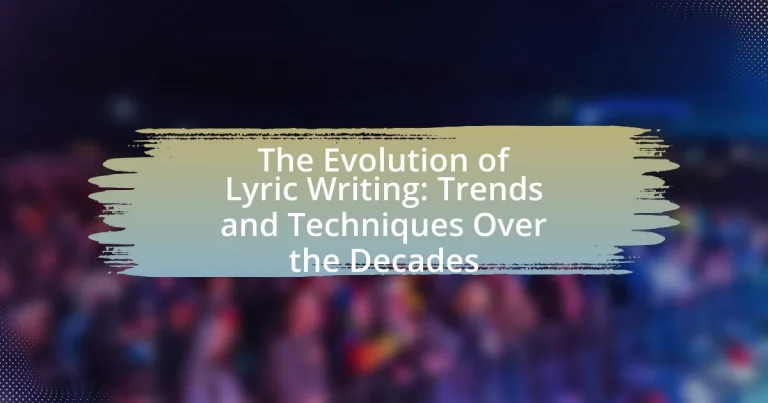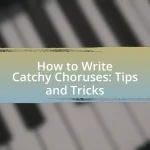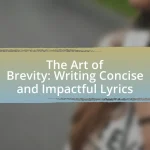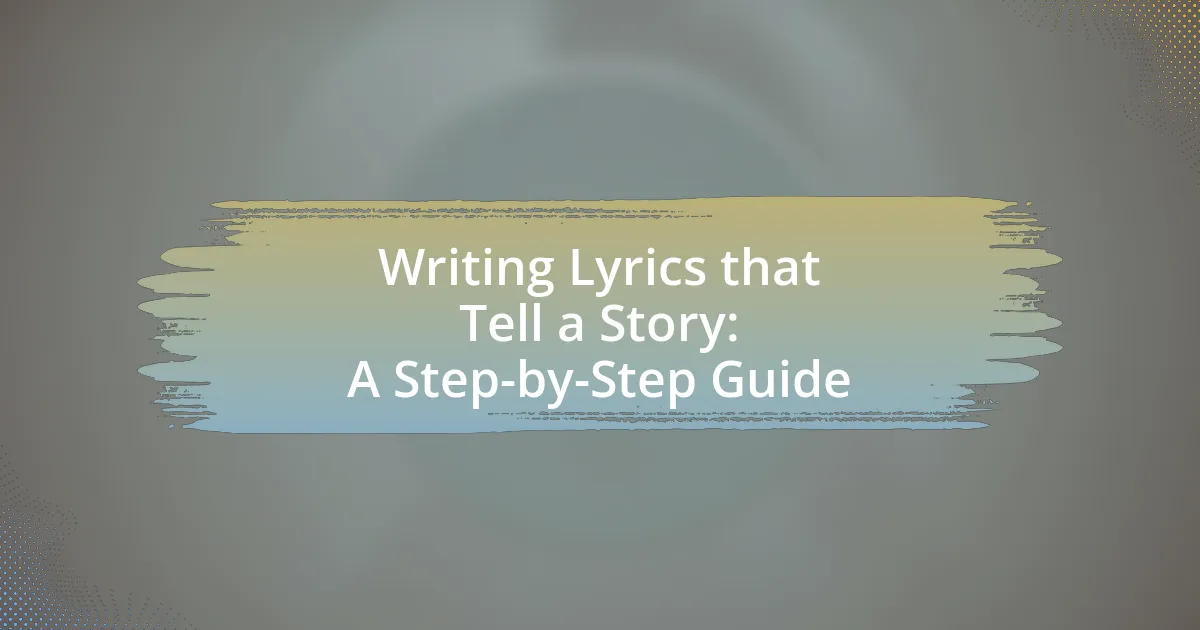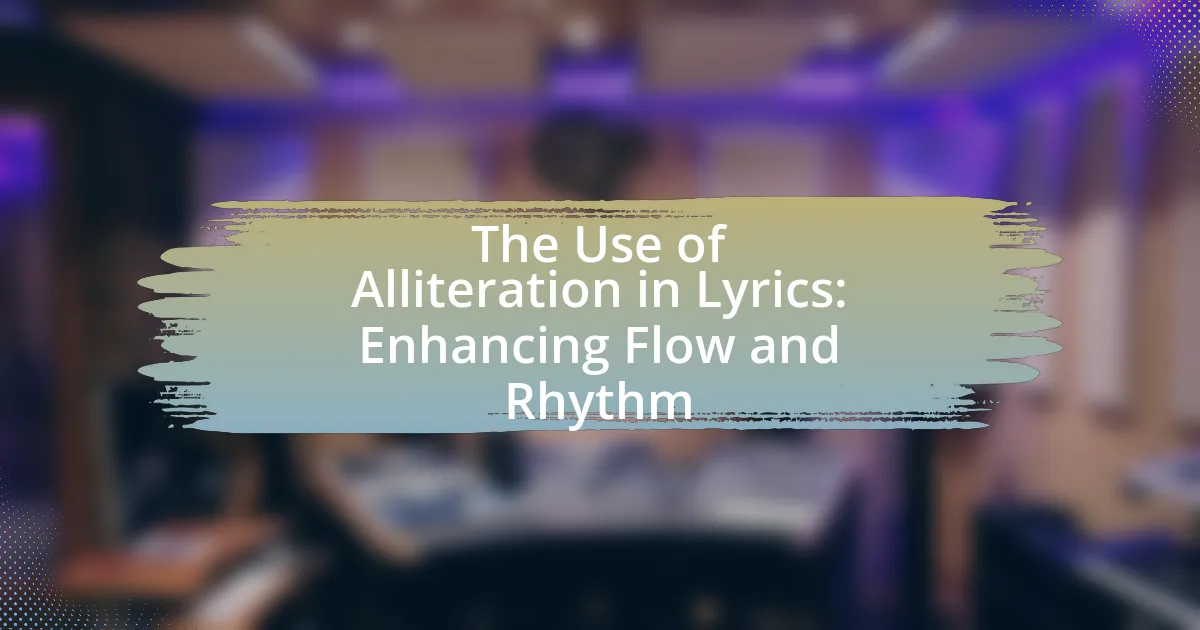The article examines the evolution of lyric writing, highlighting its transformation across cultural, social, and musical contexts over time. It traces the origins of lyrics from ancient oral traditions to modern expressions influenced by genres such as folk, rock, and hip-hop. Key trends in lyric writing are discussed, including the impact of historical events, cultural shifts, and technological advancements on lyrical themes and techniques. The article also explores the role of storytelling, rhyme schemes, and the influence of social and political movements in shaping contemporary lyricism, while addressing future trends in the industry.
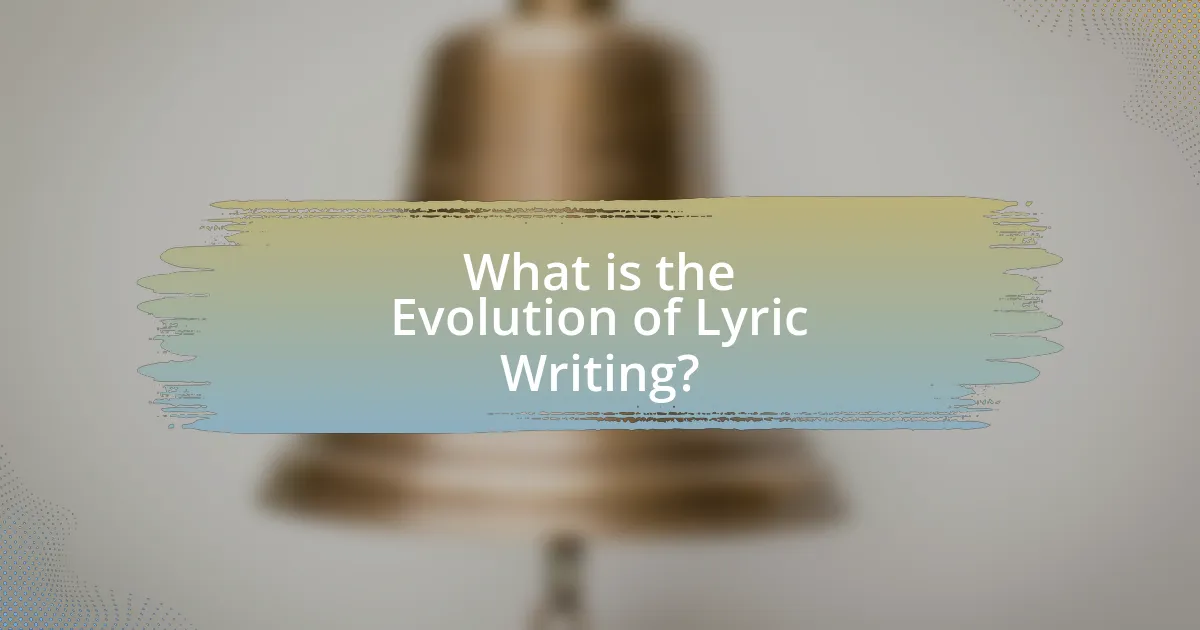
What is the Evolution of Lyric Writing?
The evolution of lyric writing reflects changes in cultural, social, and musical contexts over time. Initially, lyrics were often rooted in oral traditions, with early examples found in ancient texts like the “Epic of Gilgamesh” and Greek tragedies, which emphasized storytelling and moral lessons. As music genres developed, particularly in the 20th century, lyric writing began to incorporate personal experiences and emotions, exemplified by the rise of folk and rock music, where artists like Bob Dylan and The Beatles transformed lyrics into a medium for social commentary and personal expression.
The introduction of hip-hop in the late 20th century further revolutionized lyric writing, emphasizing rhythm, wordplay, and narrative, with artists like Nas and Kendrick Lamar pushing the boundaries of lyrical complexity and thematic depth. Today, lyric writing continues to evolve, influenced by digital technology and global connectivity, allowing for diverse styles and collaborations across genres, as seen in contemporary artists like Billie Eilish and Drake, who blend various influences to create innovative lyrical content.
How has lyric writing changed over the decades?
Lyric writing has evolved significantly over the decades, reflecting changes in culture, technology, and musical styles. In the 1950s and 1960s, lyrics often focused on simple themes of love and youth, characterized by straightforward language and catchy melodies, as seen in the works of artists like Elvis Presley and The Beatles. The 1970s introduced more complex narratives and social commentary, with songwriters like Bob Dylan and Joni Mitchell using metaphor and storytelling to address political and personal issues.
By the 1980s and 1990s, the rise of hip-hop brought a new emphasis on rhythm and wordplay, with artists like Nas and Tupac Shakur incorporating intricate rhyme schemes and cultural references. The 2000s and 2010s saw a blending of genres, with pop and hip-hop artists like Taylor Swift and Drake using confessional and relatable lyrics to connect with audiences on a personal level.
Today, lyric writing continues to be influenced by digital platforms, allowing for rapid dissemination and collaboration, which has led to diverse styles and themes. The shift from traditional songwriting to more collaborative and genre-blending approaches illustrates the ongoing transformation of lyric writing in response to societal changes and technological advancements.
What historical events influenced the evolution of lyric writing?
The evolution of lyric writing has been significantly influenced by historical events such as the Romantic Movement in the late 18th and early 19th centuries, which emphasized personal expression and emotion in poetry and song. This period saw a shift from structured forms to more free and expressive styles, as exemplified by poets like William Wordsworth and John Keats, who inspired lyricists to explore themes of nature, love, and individual experience. Additionally, the rise of social movements, such as the Civil Rights Movement in the 1960s, led to the incorporation of political and social themes in lyrics, as seen in the works of artists like Bob Dylan and Nina Simone, who used their music to address issues of justice and equality. The advent of technology, including the phonograph and radio, also transformed lyric writing by allowing for wider dissemination of songs, influencing popular culture and encouraging new lyrical styles. These historical events collectively shaped the thematic and stylistic evolution of lyric writing throughout the decades.
How have cultural shifts impacted lyrical themes?
Cultural shifts have significantly impacted lyrical themes by reflecting societal changes, values, and issues. For instance, the civil rights movement in the 1960s led to an increase in songs addressing racial equality and social justice, as seen in works by artists like Bob Dylan and Nina Simone. Similarly, the rise of feminism in the 1970s influenced lyrical content, with female artists like Joan Jett and Aretha Franklin expressing empowerment and independence. In recent years, themes surrounding mental health and identity have gained prominence, driven by increased awareness and acceptance, as evidenced in the works of artists like Billie Eilish and Logic. These examples illustrate how lyrical themes evolve in response to cultural dynamics, making music a mirror of societal values and concerns.
What are the key trends in lyric writing throughout history?
Key trends in lyric writing throughout history include the evolution from simple, narrative forms to complex, introspective expressions. In the early 20th century, folk and blues lyrics often focused on storytelling and social issues, reflecting the cultural context of the time. The 1960s and 1970s saw a shift towards personal and political themes, with artists like Bob Dylan and The Beatles incorporating poetic devices and abstract concepts. The rise of hip-hop in the 1980s introduced intricate rhyme schemes and wordplay, emphasizing rhythm and social commentary. In recent decades, lyrics have increasingly embraced diverse genres and global influences, often blending personal experiences with broader societal themes, as seen in the works of artists like Beyoncé and Kendrick Lamar. This progression illustrates how lyric writing has continually adapted to cultural shifts and technological advancements, shaping the way artists communicate their messages.
Which lyrical styles emerged in the early 20th century?
The early 20th century saw the emergence of several lyrical styles, notably modernism, jazz poetry, and the Harlem Renaissance. Modernism introduced fragmented structures and stream-of-consciousness techniques, reflecting the complexities of contemporary life. Jazz poetry, characterized by its rhythmic and improvisational qualities, drew inspiration from jazz music, emphasizing spontaneity and cultural expression. The Harlem Renaissance brought forth a rich body of work that celebrated African American culture and identity, with poets like Langston Hughes and Claude McKay using lyrical forms to address social issues and personal experiences. These styles collectively marked a significant shift in lyrical expression during this period.
How did the rise of rock and roll shape lyric writing in the 1950s and 60s?
The rise of rock and roll significantly transformed lyric writing in the 1950s and 60s by introducing themes of youth rebellion, love, and social issues. This genre shifted the focus from traditional storytelling to more personal and relatable experiences, reflecting the sentiments of a younger generation. Artists like Bob Dylan and Chuck Berry incorporated social commentary and emotional depth into their lyrics, which resonated with listeners and influenced subsequent songwriters. The incorporation of colloquial language and a conversational tone became prevalent, making lyrics more accessible and engaging. This evolution in lyric writing marked a departure from the more formal and romanticized lyrics of earlier music styles, establishing a new standard for authenticity and expression in popular music.
What techniques have been used in lyric writing across different eras?
Lyric writing techniques have evolved significantly across different eras, reflecting cultural shifts and musical styles. In the early 20th century, techniques such as storytelling and simple rhyme schemes were prevalent, as seen in folk and blues music. The 1960s introduced more complex structures and abstract imagery, influenced by the counterculture movement, with artists like Bob Dylan using metaphor and social commentary. The 1980s and 1990s saw the rise of hip-hop, which emphasized rhythm, wordplay, and personal narratives, exemplified by artists like Nas and Tupac Shakur. In contemporary music, techniques often blend genres, utilizing digital tools for lyric composition and incorporating themes of identity and mental health, as demonstrated by artists like Billie Eilish. Each era’s techniques reflect the societal context and technological advancements of the time, showcasing the dynamic nature of lyric writing.
What role does storytelling play in lyric composition?
Storytelling plays a crucial role in lyric composition by providing a narrative framework that engages listeners emotionally and intellectually. This narrative structure allows songwriters to convey complex themes, experiences, and emotions through relatable characters and situations. For instance, many iconic songs, such as Bob Dylan’s “Tangled Up in Blue,” utilize storytelling to create vivid imagery and evoke strong feelings, demonstrating how effective narratives can enhance the listener’s connection to the music. Furthermore, research indicates that songs with clear storytelling elements tend to resonate more with audiences, leading to greater popularity and lasting impact in the music industry.
How have rhyme schemes and meter evolved in popular music?
Rhyme schemes and meter in popular music have evolved significantly from the early 20th century to the present day. Initially, popular music predominantly featured simple, consistent rhyme schemes and regular meter, often following the AABB or ABAB patterns, which were prevalent in folk and early jazz music. As genres diversified, particularly with the rise of rock and hip-hop, artists began experimenting with more complex rhyme schemes, including internal rhymes and slant rhymes, as well as varied meter, allowing for greater lyrical flexibility and expression.
For instance, hip-hop artists in the late 20th century, such as Nas and Eminem, introduced intricate multi-syllabic rhymes and syncopated rhythms, which contrasted sharply with the straightforward structures of earlier pop music. This shift not only showcased lyrical dexterity but also reflected broader cultural changes, emphasizing storytelling and personal expression. The evolution continued into the 21st century, where artists like Kendrick Lamar and Taylor Swift blend various styles, incorporating unconventional rhyme schemes and meters that challenge traditional forms, thus pushing the boundaries of lyrical creativity in popular music.
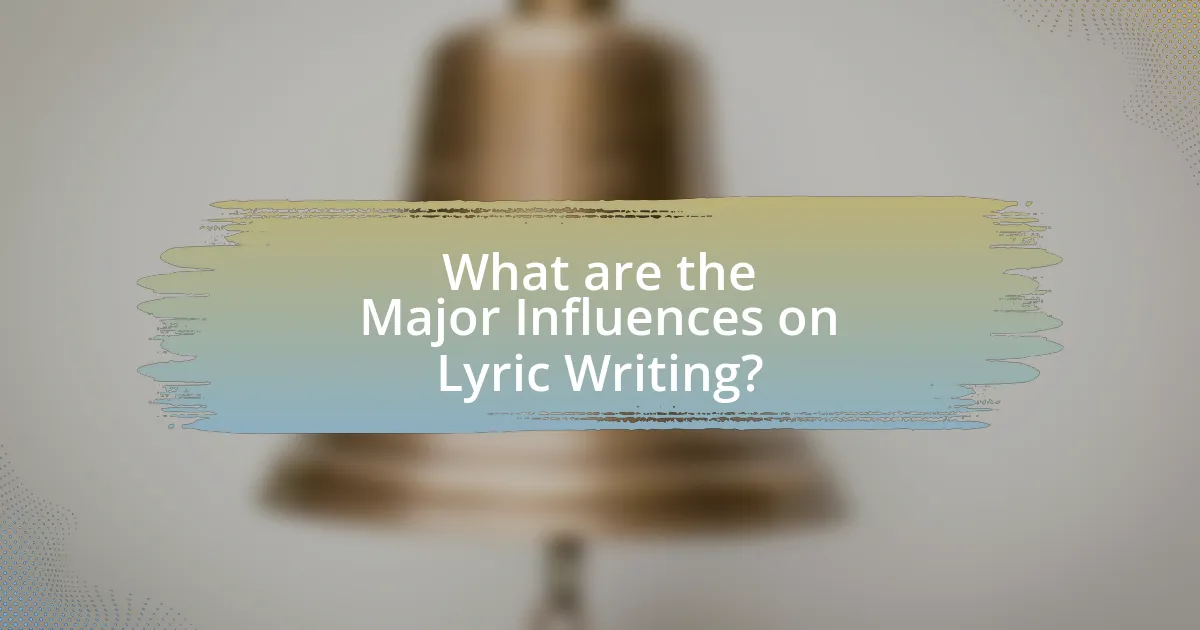
What are the Major Influences on Lyric Writing?
Major influences on lyric writing include personal experiences, cultural context, and musical genre. Personal experiences shape the emotional depth and authenticity of lyrics, as artists often draw from their own lives to convey relatable themes. Cultural context plays a significant role, as societal issues, historical events, and prevailing attitudes inform the subject matter and style of lyrics. Additionally, the musical genre influences lyrical content and structure; for example, hip-hop often emphasizes storytelling and rhythm, while pop music may focus on catchy hooks and universal themes. These influences collectively contribute to the evolution of lyric writing across different decades.
How do musical genres affect lyric writing styles?
Musical genres significantly influence lyric writing styles by dictating thematic content, language, and structure. For instance, hip-hop often employs intricate rhyme schemes and storytelling, reflecting cultural narratives and personal experiences, while country music typically focuses on storytelling with relatable themes of love and heartache, using straightforward language. Additionally, rock lyrics may emphasize emotional expression and rebellion, often utilizing metaphor and imagery. These genre-specific characteristics shape how artists convey messages, engage audiences, and reflect societal issues, demonstrating that the style of lyrics is closely tied to the conventions and expectations of each musical genre.
What are the differences in lyrics between pop, rock, and hip-hop?
Pop lyrics typically focus on themes of love, relationships, and personal experiences, often employing catchy hooks and repetitive structures to enhance memorability. In contrast, rock lyrics frequently explore themes of rebellion, social issues, and emotional struggles, characterized by a more narrative style and complex vocabulary. Hip-hop lyrics are distinguished by their emphasis on storytelling, cultural commentary, and rhythmic wordplay, often incorporating slang and a conversational tone to reflect the artist’s background and experiences. These differences highlight the unique stylistic approaches each genre takes in conveying messages and emotions through lyrics.
How does the audience’s demographic influence lyrical content?
The audience’s demographic significantly influences lyrical content by shaping themes, language, and cultural references. For instance, artists often tailor their lyrics to resonate with the age, gender, socioeconomic status, and cultural background of their listeners. Research indicates that hip-hop lyrics frequently reflect the experiences and challenges faced by urban youth, addressing issues like poverty and systemic inequality, which are prevalent in those communities. Similarly, pop music often incorporates relatable themes of love and relationships that appeal to a younger demographic, as evidenced by the success of artists like Taylor Swift, whose lyrics often reflect the experiences of teenage and young adult audiences. This alignment between lyrical content and audience demographics ensures that the music remains relevant and engaging, ultimately driving its popularity and commercial success.
What role do social and political movements play in lyric writing?
Social and political movements significantly influence lyric writing by providing themes, narratives, and emotional resonance that reflect societal issues. For instance, the civil rights movement in the 1960s inspired artists like Bob Dylan and Nina Simone to create powerful songs addressing racial injustice, such as “The Times They Are a-Changin'” and “Mississippi Goddam.” These lyrics not only captured the spirit of the time but also served as rallying cries for change, demonstrating how movements can shape artistic expression. Additionally, contemporary movements like Black Lives Matter have led to a resurgence of socially conscious music, with artists using their platforms to address systemic racism and inequality, further illustrating the ongoing impact of social and political contexts on lyric writing.
How have protest songs shaped lyrical themes in various decades?
Protest songs have significantly shaped lyrical themes across various decades by addressing social, political, and cultural issues relevant to their times. In the 1960s, for example, artists like Bob Dylan and Joan Baez used their music to challenge civil rights injustices and the Vietnam War, embedding themes of resistance and hope in their lyrics. The 1970s saw a continuation of this trend with songs like “Fortunate Son” by Creedence Clearwater Revival, which critiqued class disparity and the draft system, reflecting the era’s anti-establishment sentiments. In the 1980s, artists such as Public Enemy introduced themes of racial inequality and systemic oppression, using their lyrics to empower marginalized communities. The 1990s and 2000s brought a focus on global issues, with songs addressing environmental concerns and human rights, exemplified by artists like Rage Against the Machine. More recently, contemporary protest songs have tackled issues like police brutality and climate change, as seen in the works of artists like Kendrick Lamar and Billie Eilish. This evolution illustrates how protest songs have consistently influenced lyrical themes by mirroring societal struggles and inspiring collective action.
What impact do current events have on contemporary lyricists?
Current events significantly influence contemporary lyricists by shaping the themes, emotions, and narratives present in their work. For instance, social movements such as Black Lives Matter and the COVID-19 pandemic have prompted artists to address issues of racial injustice and public health in their lyrics, reflecting the urgency and relevance of these topics. Notable examples include songs like “This Is America” by Childish Gambino, which critiques systemic racism, and “I Can’t Breathe” by H.E.R., which responds directly to police brutality. These instances demonstrate how contemporary lyricists utilize current events to connect with audiences, provoke thought, and inspire change, thereby reinforcing the role of music as a form of social commentary.
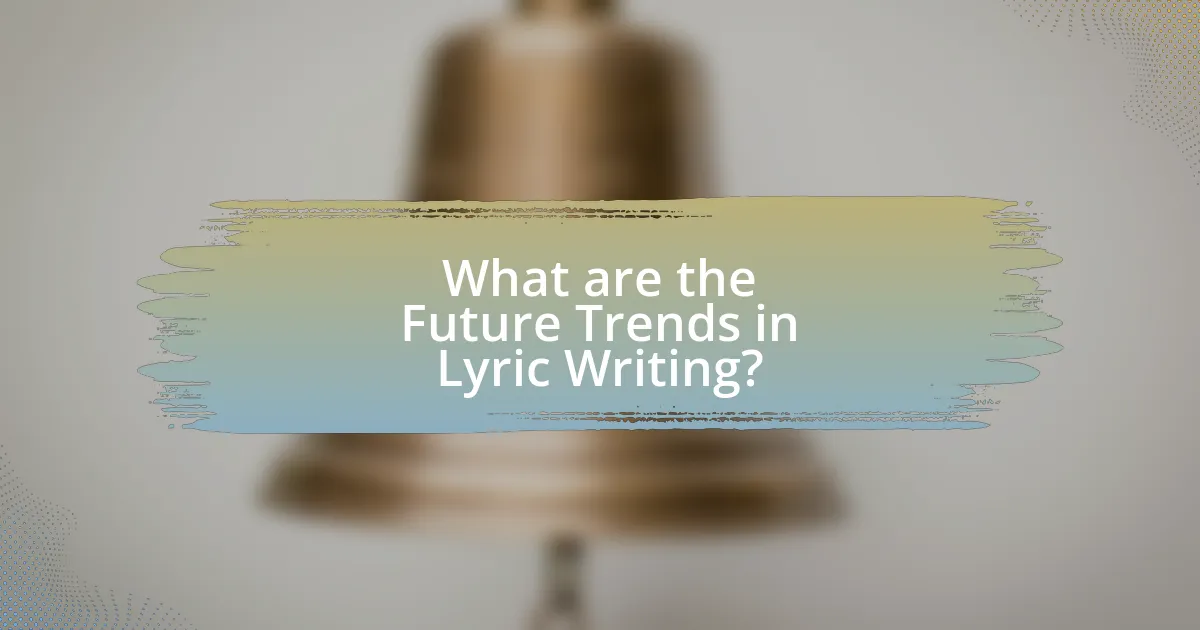
What are the Future Trends in Lyric Writing?
Future trends in lyric writing include increased collaboration through digital platforms, the integration of artificial intelligence for generating lyrics, and a focus on authenticity and personal storytelling. Digital collaboration tools allow songwriters to connect globally, enhancing creativity and diversity in lyrics. AI technologies, such as OpenAI’s GPT models, are being utilized to assist in lyric generation, providing new ideas and perspectives. Additionally, there is a growing emphasis on personal narratives and emotional honesty, reflecting societal shifts towards mental health awareness and vulnerability in art. These trends indicate a dynamic evolution in how lyrics are created and perceived in the music industry.
How is technology changing the way lyrics are written and shared?
Technology is transforming the writing and sharing of lyrics by enabling real-time collaboration and instant distribution. Digital tools such as songwriting software and apps allow artists to compose and edit lyrics more efficiently, while platforms like social media and streaming services facilitate immediate sharing with global audiences. For instance, services like SoundCloud and Bandcamp empower musicians to upload their work directly, bypassing traditional gatekeepers like record labels. This shift has led to a democratization of music, where emerging artists can gain visibility and feedback rapidly, as evidenced by the rise of viral hits on platforms like TikTok, which often originate from user-generated content.
What tools and platforms are emerging for lyricists today?
Emerging tools and platforms for lyricists today include AI-driven songwriting assistants, collaborative writing apps, and digital audio workstations (DAWs) with integrated lyric features. AI tools like OpenAI’s ChatGPT and Google’s Songsmith provide lyric generation and inspiration, allowing lyricists to brainstorm ideas quickly. Collaborative platforms such as Splice and Soundtrap enable real-time co-writing and sharing among artists, enhancing creativity and efficiency. Additionally, DAWs like Ableton Live and Logic Pro now offer built-in lyric management systems, streamlining the songwriting process. These advancements reflect the ongoing evolution of lyric writing, making it more accessible and collaborative for artists.
How does social media influence lyrical content and distribution?
Social media significantly influences lyrical content and distribution by enabling artists to engage directly with their audience and receive immediate feedback. This interaction allows musicians to tailor their lyrics to reflect current trends, social issues, and audience sentiments, resulting in more relatable and timely content. For instance, platforms like Twitter and Instagram facilitate real-time discussions about societal topics, which artists often incorporate into their lyrics to resonate with listeners. Additionally, social media serves as a primary distribution channel, allowing artists to share their music instantly with a global audience, bypassing traditional gatekeepers like record labels. According to a 2021 report by the International Federation of the Phonographic Industry, over 70% of music consumers discover new music through social media platforms, highlighting their critical role in both lyrical inspiration and distribution strategies.
What skills are essential for modern lyricists?
Essential skills for modern lyricists include strong storytelling ability, emotional intelligence, and a deep understanding of musical structure. Storytelling allows lyricists to craft compelling narratives that resonate with listeners, while emotional intelligence helps them connect with diverse audiences on a personal level. Additionally, a solid grasp of musical structure, including rhythm, rhyme schemes, and melody, is crucial for creating lyrics that complement the music effectively. These skills are supported by the fact that successful contemporary lyricists often demonstrate a blend of these abilities, leading to impactful and memorable songs that reflect current trends and cultural contexts.
How can aspiring lyricists develop their writing techniques?
Aspiring lyricists can develop their writing techniques by practicing regularly, studying successful lyrics, and experimenting with different styles. Regular practice helps to refine skills and build confidence, while analyzing the work of established artists provides insights into effective storytelling, rhyme schemes, and emotional expression. Additionally, experimenting with various genres and writing prompts encourages creativity and adaptability, essential traits for any lyricist. Research indicates that consistent writing and exposure to diverse musical influences significantly enhance a lyricist’s ability to craft compelling lyrics.
What resources are available for learning about lyric writing?
Resources for learning about lyric writing include books, online courses, workshops, and songwriting communities. Notable books such as “Writing Better Lyrics” by Pat Pattison and “The Complete Singer-Songwriter” by Jeffrey Pepper Rodgers provide foundational knowledge and techniques. Online platforms like Coursera and MasterClass offer courses taught by experienced songwriters, enhancing practical skills. Additionally, attending workshops and joining songwriting groups can provide valuable feedback and networking opportunities. These resources collectively support aspiring lyricists in developing their craft.
What best practices should lyricists follow in their writing process?
Lyricists should follow the best practice of writing regularly to enhance their skills and creativity. Consistent writing helps develop a unique voice and style, which is essential in the competitive music industry. Additionally, studying various genres and analyzing successful songs can provide insights into effective lyrical techniques. Research indicates that exposure to diverse musical forms can inspire innovation and improve lyrical quality. Furthermore, collaborating with other artists can lead to fresh ideas and perspectives, enriching the writing process.
How can lyricists effectively collaborate with musicians?
Lyricists can effectively collaborate with musicians by establishing clear communication and mutual understanding of artistic goals. This involves discussing themes, emotions, and musical styles to ensure that the lyrics complement the music. For instance, successful collaborations often occur when lyricists and musicians share references and inspirations, allowing them to align their creative visions. A notable example is the partnership between Elton John and Bernie Taupin, where their open dialogue led to iconic songs that resonate with audiences. Such collaborative efforts are supported by the fact that studies show that effective communication in creative partnerships enhances the quality of the final product.
What strategies can help lyricists overcome writer’s block?
Lyricists can overcome writer’s block by employing strategies such as free writing, setting specific goals, and collaborating with other artists. Free writing allows lyricists to express thoughts without self-censorship, which can lead to unexpected ideas and breakthroughs. Setting specific goals, such as writing a certain number of lines per day, creates a structured approach that can motivate lyricists to produce content consistently. Collaboration with other artists introduces new perspectives and ideas, often sparking creativity that can help break through mental barriers. These strategies are supported by research indicating that creative collaboration and structured practice can enhance artistic output and reduce instances of writer’s block.
